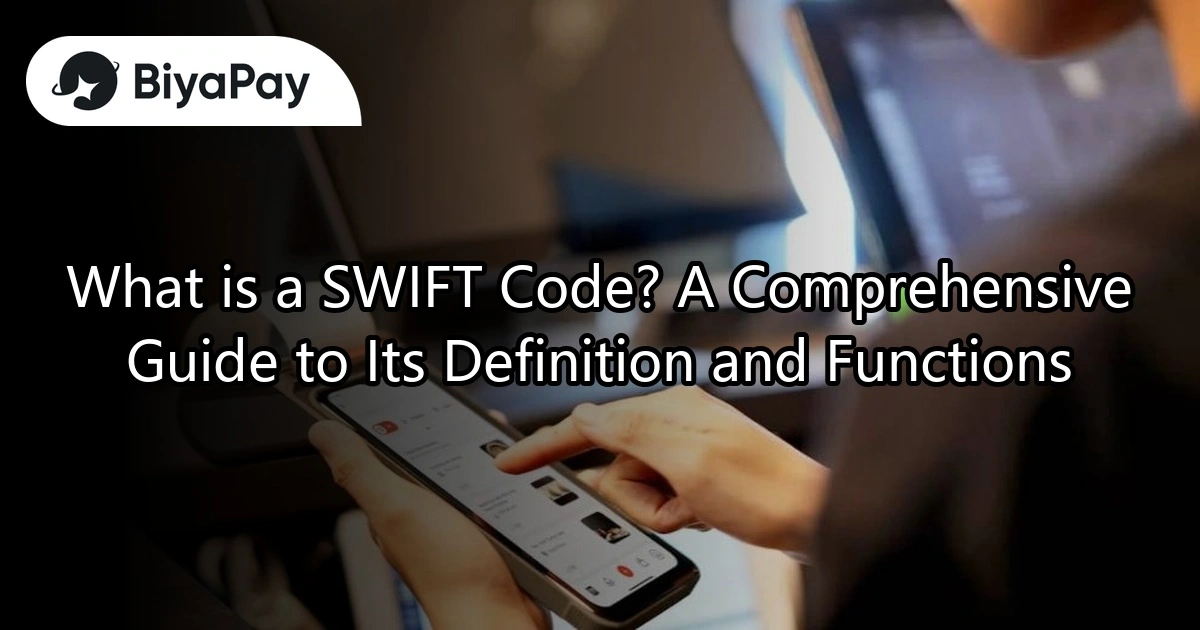- EasyCard
- Trade
- Help
- Announcement
- Academy
- SWIFT Code
- Iban Number
- Referral
- Customer Service
- Blog
- Creator
What is a SWIFT Code? A Comprehensive Guide to Its Definition and Functions

Image Source: unsplash
You may ask, what is a SWIFT code? It is a unique code assigned to a bank. When you handle international remittances, this code helps you accurately locate the recipient’s bank. Unlike other bank identifiers, a SWIFT Code is specifically used for cross-border transfers. Whenever you want to send money from a Hong Kong bank to a foreign country, this code is highly important.
Key Points
- A SWIFT Code is a bank’s international identifier, helping you accurately locate the recipient bank during cross-border remittances.
- A SWIFT Code consists of 8 to 11 letters and numbers, including bank, country, location, and branch information, and must be entered correctly.
- SWIFT Code and BIC are the same code, while IBAN is used to identify accounts; Hong Kong banks generally do not use IBAN.
- You can query SWIFT Codes through a bank’s official website, customer service hotline, or the SWIFT official platform to ensure the information is up-to-date and accurate.
- Before making international remittances, prepare complete information and carefully verify the SWIFT Code, account number, and recipient’s name to avoid delays and extra fees.
What is a SWIFT Code
Definition
You may often hear the question, what is a SWIFT code? In fact, a SWIFT Code (also known as a BIC code) is a standardized international code specifically used to identify banks. Each bank has a unique SWIFT Code. This code consists of 8 to 11 letters and numbers, with a structure that includes a bank code (4 letters), country code (2 letters), location code (2 letters), and branch code (3 letters, optional). For example, the SWIFT Code for HSBC Hong Kong is “HSBCHKHHXXX,” from which you can identify the bank, country, and branch information.
The full name of a SWIFT Code is “Society for Worldwide Interbank Financial Telecommunication Code,” and it is essentially the same as a BIC (Bank Identifier Code). In international financial transactions, you often see these two terms used interchangeably.
Main Uses
When you are making international remittances, understanding what a SWIFT code is becomes very important. The primary function of this code is to facilitate secure and standardized cross-border transactions between global financial institutions. When you transfer money from a Hong Kong bank to the U.S. or other countries, a SWIFT Code ensures your funds reach the recipient’s bank accurately. This code acts like a bank’s “ID card,” ensuring every fund reaches the correct destination.
- SWIFT Code is used for:
- Identifying the recipient bank
- Completing international wire transfers alongside account numbers and remittance details
- Enhancing the security and efficiency of fund flows
As long as you correctly enter what a SWIFT code is, along with the recipient’s account number and name, you can smoothly complete an international remittance. This code has become an indispensable standard among global banks, and whether you are an individual or a business, you need to understand and use it correctly.
Structure and Format

Image Source: unsplash
Components
When you look up a SWIFT Code, you will notice it typically consists of 8 to 11 letters and numbers. These letters and numbers are not randomly arranged but have specific meanings. You can break down a SWIFT Code into four main components:
- Bank Code: The first 4 letters represent the bank’s name. For example, “HSBC” stands for HSBC Hong Kong.
- Country Code: The 5th and 6th letters represent the bank’s country. For example, “HK” stands for Hong Kong, and “CN” stands for China.
- Location Code: The 7th and 8th letters or numbers represent the bank’s region or city. For example, “HH” indicates Hong Kong’s head office.
- Branch Code: The last 3 letters or numbers (optional) represent a specific branch. If no specific branch is indicated, “XXX” is typically used for the head office.
Tip: When filling out a SWIFT Code, you must ensure each component is correct, or the funds may be sent to the wrong bank.
Example
You can refer to the table below to understand the meaning of each SWIFT Code component:
| Component | Position | Example (HSBCHKHHXXX) | Meaning |
|---|---|---|---|
| Bank Code | Positions 1-4 | HSBC | HSBC Hong Kong |
| Country Code | Positions 5-6 | HK | Hong Kong |
| Location Code | Positions 7-8 | HH | Hong Kong Head Office |
| Branch Code | Positions 9-11 | XXX | Head Office (specific branch code if applicable) |
When making international remittances, as long as you fill in the SWIFT Code provided by the recipient bank, the funds will accurately reach their bank. Remember that SWIFT Codes for different banks and branches may have slight variations, so you should pay close attention to the accuracy of each letter and number.
Comparison with Other Identifiers
When handling international remittances, you often encounter various bank identifiers. These codes may seem similar but serve distinct purposes. You need to differentiate between SWIFT Code, BIC, IBAN, and Hong Kong bank codes to correctly fill out remittance details and avoid fund delays.
BIC
BIC (Bank Identifier Code) and SWIFT Code are actually the same thing. When you check bank documents or search online, you may see terms like “SWIFT/BIC.” Both are used to identify banks for international remittances. You can use BIC and SWIFT Code interchangeably. For example, HSBC Hong Kong’s BIC is “HSBCHKHHXXX,” identical to its SWIFT Code.
Tip: When filling out international remittance forms, if the bank requests a BIC or SWIFT Code, you can use the same code for either.
IBAN
IBAN (International Bank Account Number) is an international bank account number. When remitting to European countries, you often need to provide an IBAN. IBAN is primarily used to identify the recipient’s account, not the bank itself. Hong Kong banks generally do not use IBAN, but when you remit to Europe, the U.S., or other regions, the recipient may provide both an IBAN and a SWIFT Code. You should remember that IBAN and SWIFT Code are different pieces of information, and both must be filled out correctly.
| Code Type | Primary Use | Common in Hong Kong | Common in Europe |
|---|---|---|---|
| SWIFT/BIC | Identify Bank | ✔ | ✔ |
| IBAN | Identify Account | ✘ | ✔ |
Hong Kong Bank Code
A Hong Kong bank code is a three-digit number used for local interbank transfers. For example, HSBC Hong Kong’s bank code is “004.” You use this code for local transfers or setting up automatic payments. You should note that Hong Kong bank codes are only applicable within Hong Kong and are not used for international remittances. For international remittances, you must use a SWIFT Code.
Reminder: Local bank codes and SWIFT Codes are not interchangeable. For international remittances, you must verify the recipient bank’s SWIFT Code to ensure funds arrive safely.
Query and Usage
Query Methods
When you want to find the correct SWIFT Code, you have several options. The most direct method is to visit the bank’s official website. Most Hong Kong banks list SWIFT Codes for their branches on their websites. You can also call the bank’s customer service hotline and ask staff directly. This ensures you get the most up-to-date and accurate information.
Additionally, you can use online query tools. For example, the SWIFT official website and some major financial information platforms offer SWIFT Code lookup functions. You simply enter the bank name or location to find the relevant code. Below are common query methods:
- Bank official websites (e.g., HSBC Hong Kong, Standard Chartered, etc.)
- Bank customer service hotlines
- SWIFT official query platform
- Other financial information websites
Tip: When querying, it’s best to note the complete SWIFT Code, including the branch code, to reduce the chance of remittance errors.
Filling Precautions
When filling out a SWIFT Code, you must be extremely careful. Each letter and number represents specific information. If you enter a single letter or number incorrectly, the funds may be returned or even sent to the wrong bank. This could not only delay the remittance but also incur additional fees (e.g., a return may cost 20 to 30 USD, depending on the bank and exchange rate).
You should:
- Carefully verify the SWIFT Code provided by the recipient bank.
- Confirm the branch code is correct, especially for large banks with multiple branches.
- Fill in the recipient’s account number and name together to ensure consistency.
Reminder: Before each remittance, it’s best to reconfirm the SWIFT Code with the recipient or bank to avoid unnecessary losses and delays.
International Remittance Process

Image Source: unsplash
Required Information
When making international remittances, you must prepare the following information. These details ensure funds reach the recipient’s account smoothly:
- Recipient Bank’s SWIFT Code: This is the international code identifying the bank. For example, HSBC Hong Kong’s SWIFT Code is
HSBCHKHHXXX. - Recipient Account Number: You need to provide the complete account number to ensure accurate crediting.
- Recipient Name: Must match the name registered with the bank exactly.
- Recipient Bank Name and Address: Some countries or banks require a detailed address.
- Remittance Amount and Currency: You must confirm the amount (in USD) and select the correct currency.
- Remarks or Notes (if needed): Sometimes you need to specify the payment purpose or other details.
Tip: When filling out details, it’s best to confirm all information with the recipient to avoid remittance failures due to errors.
Precautions
When making international remittances, you should pay attention to the following to avoid unnecessary losses or delays:
- Fees: Most Hong Kong banks charge international remittance fees, typically around 20 to 40 USD per transaction, depending on the bank and destination. You should also note that the recipient bank may charge additional fees.
- Exchange Rate Fluctuations: Banks convert currencies based on the daily exchange rate. You can check the day’s USD exchange rate to calculate the actual amount received.
- Processing Time: International remittances generally take 1 to 5 business days. Processing speeds vary by bank and country.
- Data Verification: Before each remittance, verify all details, including the SWIFT Code, account number, and recipient name. Errors may lead to returns and additional fees.
- Restrictions and Regulations: Some countries have limits or additional reviews for international remittances. You can consult the bank for relevant policies.
| Item | Description |
|---|---|
| Fees | Approximately 20-40 USD, depending on the bank |
| Processing Time | 1-5 business days |
| Exchange Rate | Calculated based on the daily USD rate |
| Return Fees | Errors may incur 20-30 USD fees |
Reminder: Before remitting, understand all fees and regulations and stay in contact with the recipient to ensure funds arrive safely.
You now understand what a SWIFT code is and its importance in international remittances. Before each remittance, you should double-check all details, including the SWIFT Code, account number, and recipient name. Correctly querying and using this information can help you avoid unnecessary losses and delays.
Tip: Keep information accurate to ensure your funds reach their destination safely.
FAQ
What’s the difference between a SWIFT Code and a BIC?
You will find that a SWIFT Code and a BIC are actually the same code. They can be used interchangeably. For international remittances, you only need to provide one of them.
What happens if I enter the wrong SWIFT Code?
If you enter the wrong SWIFT Code, the funds may be returned. Banks typically charge a 20 to 30 USD handling fee. You should double-check the details.
Do Hong Kong banks have IBANs?
When you open an account with a Hong Kong bank, you won’t receive an IBAN. IBANs are mainly used in European countries. For remittances to Europe, the recipient will provide an IBAN.
How do I find the correct SWIFT Code?
You can visit the bank’s official website, call the customer service hotline, or use SWIFT’s official query tool. You should rely on the bank’s latest announcements.
What information is needed for international remittances?
| Required Information | Description |
|---|---|
| SWIFT Code | Recipient bank’s international code |
| Account Number | Recipient’s complete account number |
| Recipient Name | Must match bank registration |
| Bank Name and Address | Some countries require detailed address |
In 2025, SWIFT Codes remain essential for secure, accurate international transfers, guiding funds to the right global destinations. BiyaPay streamlines cross-border financial management with a single account for Hong Kong and U.S. stock trading and a wealth management product offering up to 5.48% annualized return, accessible anytime with flexible withdrawals—no additional overseas accounts needed. Start now at BiyaPay!
BiyaPay supports real-time conversions across multiple fiat and digital currencies with transparent rate queries, minimizing costs with remittance fees as low as 0.5%, compared to traditional banks’ $20-40 fees. Regulated by international financial authorities, it ensures secure, reliable transactions, enhancing efficiency in managing cross-border funds. Visit BiyaPay today to seize financial opportunities!
*This article is provided for general information purposes and does not constitute legal, tax or other professional advice from BiyaPay or its subsidiaries and its affiliates, and it is not intended as a substitute for obtaining advice from a financial advisor or any other professional.
We make no representations, warranties or warranties, express or implied, as to the accuracy, completeness or timeliness of the contents of this publication.




Contact Us
Company and Team
BiyaPay Products
Customer Services
is a broker-dealer registered with the U.S. Securities and Exchange Commission (SEC) (No.: 802-127417), member of the Financial Industry Regulatory Authority (FINRA) (CRD: 325027), member of the Securities Investor Protection Corporation (SIPC), and regulated by FINRA and SEC.
registered with the US Financial Crimes Enforcement Network (FinCEN), as a Money Services Business (MSB), registration number: 31000218637349, and regulated by FinCEN.
registered as Financial Service Provider (FSP number: FSP1007221) in New Zealand, and is a member of the Financial Dispute Resolution Scheme, a New Zealand independent dispute resolution service provider.




















